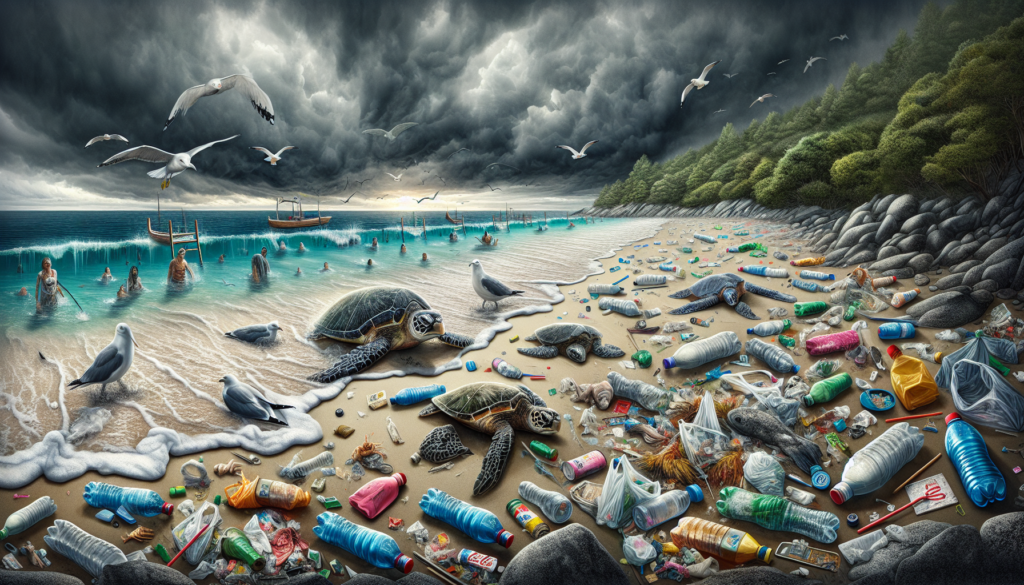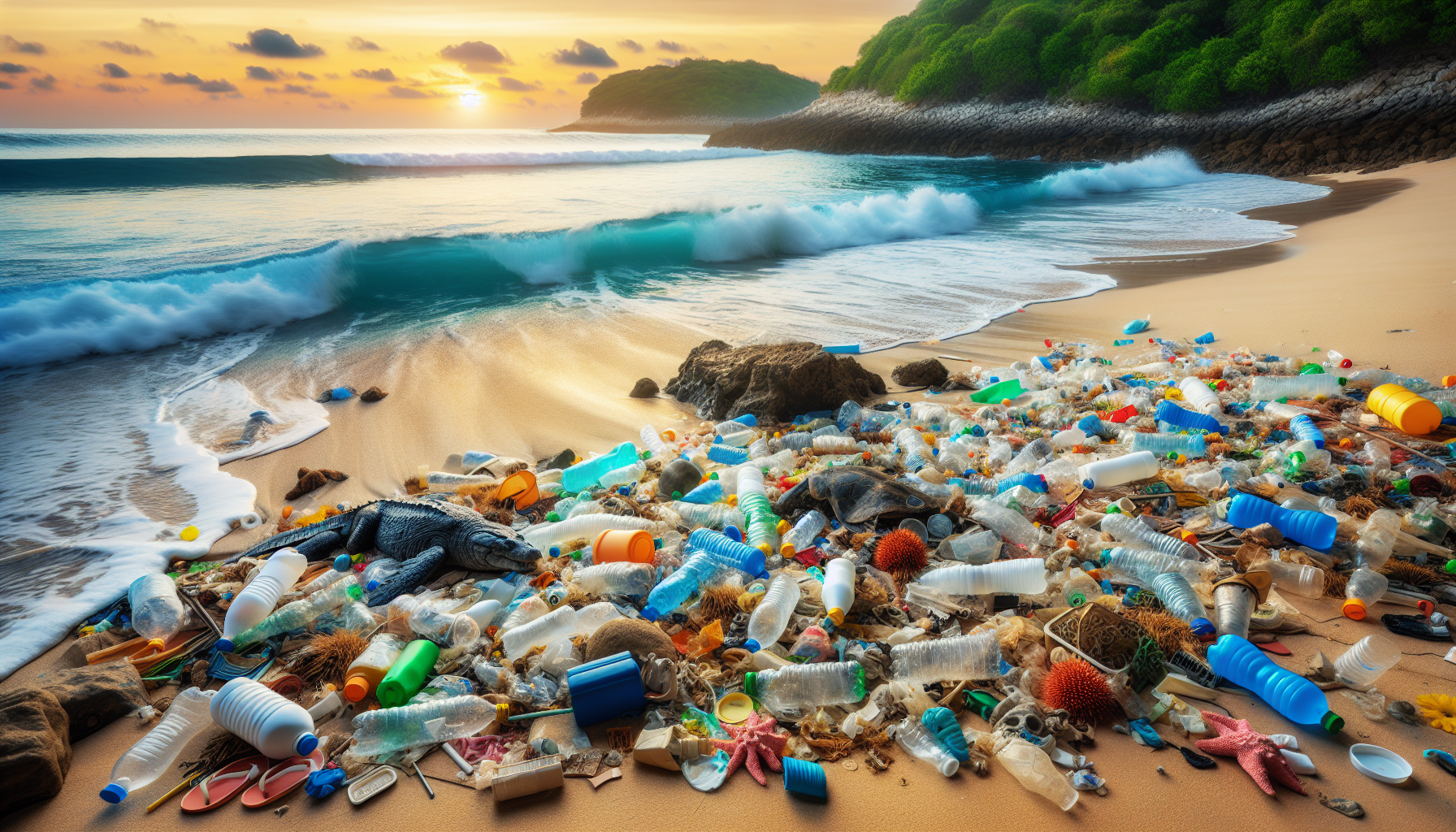Did you know that your everyday use of single-use plastics has a significant impact on the environment? From plastic bags to disposable cutlery, these convenient items might seem harmless, but they contribute to a growing ecological problem. In this article, we’ll explore the environmental consequences of single-use plastics, shedding light on the unseen effects and the importance of adopting more sustainable alternatives. Together, we can make a difference in preserving our planet for future generations.

Overview of Single-Use Plastics
Single-use plastics are items that are designed to be used only once before they are discarded. They include products such as plastic bags, straws, water bottles, food packaging, and disposable cutlery. These plastics are typically made from fossil fuels, primarily oil and gas, and have become a significant environmental concern due to their widespread use and improper disposal.
Definition of Single-Use Plastics
Single-use plastics are defined as products that are intended to be used once before being thrown away or recycled. They are typically made from low-cost materials and are designed for convenience and short-term use. These plastics have a short lifespan and constitute a significant portion of plastic waste in landfills, oceans, and waterways.
Types of Single-Use Plastics
There are various types of single-use plastics that are commonly used in our everyday lives. Some of the most commonly found single-use plastics include plastic bags, plastic straws, disposable water bottles, plastic cutlery, food packaging, and styrofoam containers. These items are often used for a short period of time and then discarded, contributing to the growing plastic waste problem.
Production and Consumption
The production and consumption of single-use plastics have reached alarming levels in recent years, contributing to the environmental crisis we face today.
Global Production of Single-Use Plastics
The global production of single-use plastics has been increasing steadily over the years. According to estimates, over 300 million metric tons of plastics were produced worldwide in 2020, with a significant portion being single-use plastics. This exponential growth in production can be attributed to the increased demand for convenience and the rising global population.
Consumption of Single-Use Plastics
The consumption of single-use plastics is driven by our daily habits and societal norms. From take-out meals to bottled water, single-use plastics have become deeply ingrained in our lifestyle. The convenience they offer and the lack of viable alternatives have contributed to their widespread use. However, this consumption pattern has severe consequences for the environment, including plastic pollution and resource depletion.
Pollution and Waste Accumulation
The improper disposal and accumulation of single-use plastics have led to widespread pollution, particularly in oceans, waterways, and land.
Plastic Pollution in Oceans and Waterways
Plastic pollution in oceans and waterways has reached alarming levels. It is estimated that over 8 million metric tons of plastic waste enter the world’s oceans every year. This plastic pollution poses a significant threat to marine life, as animals often mistake plastic debris for food or become entangled in it. The presence of plastics in marine ecosystems disrupts the natural balance and has long-term consequences for the health of our oceans.
Land-based Plastic Pollution
Plastics that are not properly disposed of or recycled often end up in landfills. Over time, these landfills can become overwhelmed with plastic waste, leading to negative impacts on the environment. Improper landfill management can result in leaching of toxic chemicals into the soil and water, further contributing to pollution. Land-based plastic pollution is a significant issue that requires immediate attention and solutions.
Impact on Wildlife and Marine Life
The impact of single-use plastics on wildlife and marine life is devastating. Animals, birds, and marine creatures are often entangled in plastic debris, leading to injuries and death. Many marine species mistake plastic waste for food, ingesting it and suffering from internal damage or starvation. The presence of single-use plastics in their habitats disrupts their natural behavior and can cause severe population decline. The long-term consequences of these impacts on ecosystems are yet to be fully understood.
Greenhouse Gas Emissions
The production and disposal of single-use plastics contribute to greenhouse gas emissions, exacerbating climate change.
Carbon Footprint of Single-Use Plastics
The carbon footprint of single-use plastics is significant due to the energy-intensive process involved in their production. Extracting and refining the fossil fuels needed to make plastic contributes to greenhouse gas emissions. Additionally, the transportation of these plastics, as well as their disposal through landfill or incineration, further adds to carbon emissions. Overall, single-use plastics significantly contribute to the carbon footprint of our daily lives.
Emissions from Production and Disposal
The production and disposal of single-use plastics result in emissions of greenhouse gases, including carbon dioxide and methane. These emissions occur throughout the entire lifecycle of single-use plastics, from extraction and refining of raw materials to the manufacturing process and eventual disposal. The harmful effects of these emissions contribute to climate change, leading to rising global temperatures and other environmental consequences.

Toxic Chemicals and Health Risks
Single-use plastics contain toxic chemicals that can pose serious health risks to both humans and wildlife.
Chemicals Released by Single-Use Plastics
Single-use plastics often contain chemicals such as phthalates, bisphenols, and flame retardants. These chemicals can leach into food and beverages, especially when plastics are exposed to heat or acidic conditions. When ingested, these chemicals can disrupt hormonal function, lead to reproductive issues, and increase the risk of certain cancers. The presence of these chemicals in the environment also poses a threat to wildlife and ecosystem health.
Microplastics and Their Effects on Human Health
Microplastics, tiny pieces of plastic less than 5mm in size, have become a pervasive issue in our environment. These microplastics are found in various sources, including single-use plastics. When consumed via contaminated food or water, microplastics can accumulate in the human body and potentially lead to adverse health effects. The long-term consequences of microplastic ingestion on human health are still being studied, but the evidence suggests potential risks that demand further investigation.
Lack of Recycling Infrastructure
The lack of proper recycling infrastructure poses a significant challenge to managing single-use plastics effectively.
Challenges in Single-Use Plastic Recycling
Single-use plastics pose unique challenges to the recycling process due to their often complex composition. Many products contain multiple types of plastics or other materials, making them difficult to recycle efficiently. Additionally, the contamination of single-use plastics with food waste or other non-recyclable materials further complicates recycling efforts. These challenges highlight the need for improved recycling technologies and a shift towards more recyclable materials.
Limited Recycling Rates
Despite efforts to promote recycling, the recycling rates for single-use plastics remain relatively low. In some cases, these materials are not accepted by local recycling facilities or are not economically viable to recycle. As a result, a significant amount of single-use plastics end up in landfills or incinerated, exacerbating the waste management issue and environmental impact.
Landfill and Incineration Issues
The disposal of single-use plastics through landfills and incineration poses its own set of challenges and environmental concerns.
Excess Plastic Waste in Landfills
The disposal of single-use plastics in landfills contributes to the growing waste problem. As single-use plastics have a long decomposition time, they can remain in landfills for hundreds of years. Over time, the capacity of landfills can be exceeded, leading to the need for more land space and potential environmental contamination. Proper waste management practices and reducing the reliance on single-use plastics are key to addressing this issue.
Negative Impacts of Incineration
Incineration, often used as a method to dispose of single-use plastics, can have negative consequences for the environment. When plastic is burned, toxic chemicals are released into the air, contributing to air pollution. These emissions can have harmful effects on human health and the environment. While waste-to-energy incineration has been promoted as an alternative, it does not address the root problem of excessive plastic consumption and waste generation.
Alternatives to Single-Use Plastics
Finding sustainable alternatives to single-use plastics is critical in mitigating their environmental impact.
Biodegradable and Compostable Alternatives
Biodegradable and compostable alternatives to single-use plastics offer a potential solution to the waste problem. These materials are designed to break down naturally over time, reducing the accumulation of plastic waste in landfills and oceans. However, it is essential to ensure that these alternatives are actually compostable in real-life conditions and do not contribute to other environmental issues such as deforestation or excessive water usage in their production.
Reusable Products and Packaging
Shifting towards reusable products and packaging is another effective strategy to reduce the consumption of single-use plastics. Using durable alternatives like reusable shopping bags, water bottles, and food containers can significantly reduce plastic waste. Adopting a refillable mindset and encouraging businesses to provide refill stations for personal care and cleaning products can further promote the use of reusable alternatives.
Legislations and Bans
Governments around the world are taking action to address the issue of single-use plastics through legislation and bans.
Governmental Actions to Address Single-Use Plastics
Many governments have implemented or proposed various measures to tackle single-use plastics. These actions include bans, fees, and taxes on certain items, as well as the promotion of alternatives and recycling programs. By enacting legislation, governments aim to reduce plastic waste, encourage sustainable alternatives, and create a more circular economy.
International Initiatives and Agreements
International organizations and initiatives are also playing a crucial role in addressing the issue of single-use plastics. The United Nations Environment Programme (UNEP) launched the Clean Seas campaign, which aims to reduce marine plastic pollution through collaboration with governments, businesses, and individuals. Additionally, agreements such as the Basel Convention and the Global Plastic Action Partnership seek to address the global plastic waste crisis through coordinated international efforts.
Individual and Collective Responsibility
Addressing the environmental impact of single-use plastics requires individual and collective responsibility.
Role of Individuals in Reducing Single-Use Plastics
As individuals, we can make a significant impact by adopting simple lifestyle changes. This includes reducing our consumption of single-use plastics, recycling properly, and supporting businesses that offer sustainable alternatives. By making conscious choices and raising awareness about the issue, individuals can contribute to the larger movement towards a plastic-free future.
Corporate and Industry Responsibility
Beyond individual actions, corporate and industry responsibility is crucial in reducing the use of single-use plastics. Companies must prioritize sustainable packaging and product design, invest in recycling infrastructure, and explore innovative solutions to minimize their environmental footprint. By taking responsibility for their actions and actively seeking sustainable alternatives, businesses can play a key role in driving positive change.
In conclusion, the environmental impact of single-use plastics is a complex issue that requires urgent attention and action. From pollution in oceans and waterways to greenhouse gas emissions and health risks, the negative consequences of single-use plastics are far-reaching. However, through a combination of individual efforts, government legislation, and industry responsibility, we can work towards a more sustainable future, minimizing the use of single-use plastics and preserving our environment for future generations.

